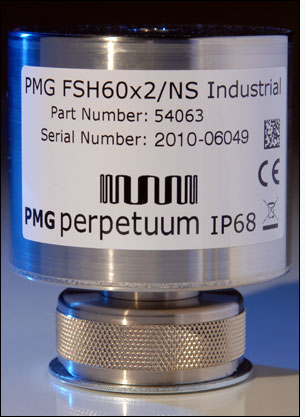National Instruments, a Texas-based test and measurement equipment company, is partnering with energy-harvesting technology provider Perpetuum to offer a measurement node network that can be powered wirelessly, without batteries. According to Keith Abate, Perpetuum’s director of business development, Perpetuum’s vibration energy-harvesting technology can power National Instruments’ sensor nodes by drawing energy from the vibrations of the very machine that the sensor is monitoring. What’s more, sensors that track vibration levels within the machine, in order to monitor that device’s health, can also draw power from those same vibrations.
The energy-harvesting technology, Abate says, operates with National Instruments’ latest node: the NI WSN-3226, which is commercially available now. The device can also be powered in an outdoor setting, with a solar energy-harvesting system provided by Solarcraft Power Products. In both cases, the harvesting system will be sold separately by the technology providers, and can be wired to the sensor nodes.

Energy harvesting provides an alternative to batteries for sensor nodes that typically require a power supply of 9 to 30 volts, Abate says. The benefit, he notes, is the wireless power supply’s lifespan—decades, rather than a few years in the case of batteries. The sensor nodes harvest energy to power not only the sensors in the devices, but also the transmitters that send data at preset intervals to gateways, at 2.4 GHz. Although there are several options for energy harvesting—including solar, wind or thermal energy—Perpetuum’s electromagnetic micro-generator (which converts vibration energy to electrical energy) takes advantage of a common environmental byproduct of machinery found within industrial settings. The harvester generates approximately three to 10 volts of power when a machine to which it is attached is vibrating.
National Instruments provides wireless sensor network (WSN) technology to help industrial firms track their machinery’s health, by measuring the conditions around those devices. If a machine gets too hot or cold, for example, or vibrates excessively, that can indicate a problem that, if addressed quickly, can ensure the machine does not break down, or interfere with the company’s productivity.
Although sensors that monitor the health of critical equipment, such as gas turbines that run an entire facility, are typically wired to guarantee they never fail, there has been an increase in the use of wireless sensors for other equipment, Abate says, such as compressors and pumps. “The biggest problem is that batteries wear out,” he explains, thereby creating a need for industrial plants to replace sensor batteries at regular intervals, in order to avoid risking a sensor failure. Some factories have hundreds of sensors in place, making frequent replacements a time-consuming—and, at times, hazardous—process.
According to Abate, the electromagnetic vibration harvesting technology comes with a magnet that moves with a machine’s vibration to create energy. The system then provides that energy to a storage bank located within the sensor device, so that power can be drawn from that bank every time the sensor takes a measurement and then transmits that data. The harvester’s lifespan, he says, is estimated at 20 years, though he notes that it could potentially last for centuries.
“We’re not advocating that our technology replace batteries,” Abate states. “The batteries are still there to provide backup power,” in the event, for instance, that a machine were deactivated for the purpose of installation or maintenance—in which case, the vibration power source might be eliminated. In such a scenario, Abate says, “The device will automatically switch over to battery power.”
In addition to its arrangement with National Instruments, Abate says, Perpetuum is partnering with GE Energy, and is also currently in discussions with Honeywell, Emerson Process Management and Siemens to provide a similar solution.
“The vibration EH [energy-harvesting] solution is ideal for machine condition monitoring applications in which you can harvest energy from the very machines you are interested in monitoring,” says Nicholas Butler, National Instruments’ product marketing manager for wireless sensor networks.
The company’s partnership with Perpetuum was announced this month, and National Instruments is discussing the energy-harvesting solution with several other potential customers as well, including the University of Texas at Austin’s Department of Civil, Architectural and Environmental Engineering, which is seeking a solar and vibration energy-harvesting system to power National Instruments’ wireless sensor nodes for use in monitoring bridges, dams and tunnels throughout central Texas.
According to Abate, the system can also be employed with sensors provided by other manufacturers.



